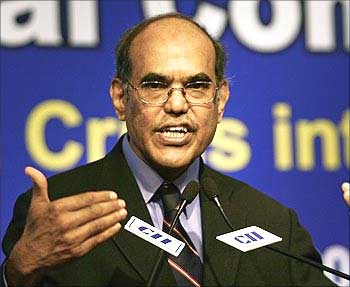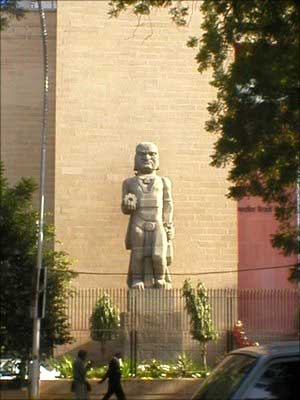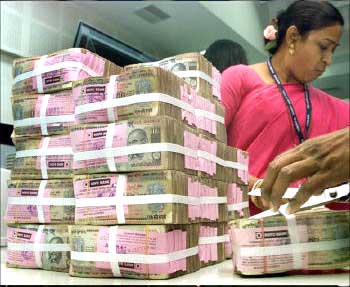Photographs: Vijay Mathur/Reuters
The Reserve Bank of India on Tuesday kept the key rates unchanged and said there are progressive signs of economic recovery but warned that the overall scenario continued to be uncertain with fiscal consolidation posing a challenge.
While RBI projected economic growth of 6 per cent with upward bias for the current fiscal, it added that inflation will firm up to 5 pc by March 2010.
Highlights:
- The bank rate has been retained unchanged at 6.0 per cent.
Repo rate
- The repo rate under the Liquidity Adjustment Facility (LAF) has been retained unchanged at 4.75 per cent.
Reverse Repo rate
- The reverse repo rate under the LAF has been retained unchanged at 3.25 per cent. The Reserve Bank has the flexibility to conduct repo/reverse repo auctions at a fixed rate or at variable rates as circumstances warrant.
Cash Reserve Ratio
- The cash reserve ratio (CRR) of scheduled banks has been retained unchanged at 5.0 per cent of net demand and time liabilities (NDTL).
RBI keeps key rates unchanged
The Indian economy experienced a significant slowdown in 2008-09 in comparison with the robust growth performance in the preceding five years, largely due to the knock-on effect of the global financial crisis.
The worst hit has been the export sector, which has been recording negative growth since October 2008.
The financial sector, however, remained relatively unaffected despite the severe stress caused by the global deleveraging process, which triggered capital outflows in the second half of 2008-09.
Large domestic demand bolstered by government consumption, provision of forex and rupee liquidity coupled with sharp cuts in policy rates, a sound banking sector and well-functioning financial markets helped cushion the economy from the worst impact of the crisis.
There are now signs of an upturn in industrial production and revival of credit demand, though the delayed monsoon has increased the downside risks to agricultural production.
This First Quarter Review of Monetary Policy for 2009-10 is thus set in the context of a stabilising global economy and gradually recovering domestic economy.
RBI keeps key rates unchanged
The Indian economy grew by 6.7 per cent in 2008-09 according to the revised estimates of the Central Statistical Organisation - better than most analysts had expected, but lower than the growth of 9.0 per cent in 2007-08.
The deceleration in GDP growth was particularly pronounced during the second half of 2008-09, largely due to the adverse impact of the global economic crisis.
Agriculture
The agriculture sector, which recorded an average annual growth rate of 4.9 per cent during 2003-08, expanded only
by 1.6 per cent during 2008-09.
In 2008-09, foodgrains production was 233.9 milliontonnes, up from 230.8 million tonnes last year. This was also an all-time high.
Allied activities - horticulture, floriculture, forestry, livestock and fisheries - which account for a substantial share in agriculture remained buoyant.
However,the production of commercial crops such as major oilseeds, cotton, jute and sugarcane was lower. Looking ahead to the current year, the progress of the southwest monsoon has been slow and halting.
RBI keeps key rates unchanged
Inflation
The headline inflation, as measured by year-on-year variations in the wholesale price index (WPI), decelerated from a peak of 12.91 per cent on August 2, 2008 to 0.84 per cent at end-March 2009 and turned negative in June 2009.
The increased volatility in WPI inflation needs to be seen in the context of the behaviour of the global commodity prices.
Reflecting the sharp increase in oil and metal prices, WPI inflation had risen to double digits in June 2008 and remained elevated till October 2008 tracking the firm global commodity prices.
As the global commodity prices moderated from their peak levels, domestic prices also adjusted, setting off a converse
movement in WPI inflation.
WPI inflation for the week ended July 11, 2009 was (-)1.17 per cent. The negative WPI inflation is expected to persist
for a few more months till the base effect wears off.
RBI keeps key rates unchanged
Image: A statue of Yaksha (servant of Kuber God of wealth) stands guard at RBI.Interest rates
Since mid-September 2008, the Reserve Bank has reduced policy rates significantly: the repo rate by 425 basis points and the reverse repo rate by 275 basis points.
Taking cues from the reduction in the Reserve Bank's policy rates and the easy liquidity conditions, all public sector banks, most private sector and foreign banks have reduced their deposit and lending rates.
The reduction in term deposit rates between October 2008 and July 20, 2009 has been in the range of 125-325 basis points by public sector banks, 100-375 basis points by private sector banks and 125-300 basis points by five major foreign banks.
The reduction in the range of BPLRs was 125-275 basis points by public sector banks, followed by 100-125 basis points by private banks and 125 basis points by five major foreign banks.
The effective lending rate is expected to have declined further in Q1 of 2009-10. In effect, the BPLRs of banks have turned out to be the maximum lending rates in most cases, distorting their information content.
RBI keeps key rates unchanged
Industry
Industrial sector growth decelerated significantly to 2.6 per cent in 2008-09 from 8.5 per cent in the previous year due largely to negligible/negative growth during four months in the second half of the year.
This pushed down the growth rate of the index of industrial production (IIP) to an abysmally low of 0.4 per cent during the second half of 2008-09 from 5.0 per cent in the first half. During April-May 2009, however, industrial growth turned positive with IIP increasing by 1.9 per cent.
While growth in the basic, intermediate and consumer durable goods sectors picked up, the capital goods and consumer nondurable sectors showed negative growth.
The core infrastructure sector, with a weight of 26.7 per cent in the IIP, recorded a higher growth of 4.8 per cent during April-June 2009, up from 3.5 per cent in the corresponding period in the previous year.
The leading indicators of industrial production, both quantitative and qualitative, suggest that the recent downturn has been arrested and a pick-up is on the way forward, albeit with some lag.
RBI keeps key rates unchanged
Image: Reserve Bank of IndiaServices
The performance of the services sector during April-May 2009 presents a mixed but predictable picture.
Trade-related services such as cargo handled at major sea and airports, as also passengers handled at international terminals continue to show deceleration/negative growth.
Domestic activity-related services such as communication and construction are showing signs of upturn.
Corporate performance
The performance of the private non-financial corporate sector deteriorated in the second half of 2008-09, reflecting
both demand slowdown and moderation in prices.
Profit margins were eroded by deceleration in sales, increased interest outgo, significant drop in non-sales income and losses on foreign currency related transactions.
Early corporate results for Q1 of 2009-10 indicate moderate sales growth over Q4 of 2008-09 with improved profit margins.
RBI keeps key rates unchanged
Fiscal
The ratio of tax receipts to GDP of the Central Government has declined from a peak of 12.6 per cent of GDP in 2007-08 to 11.8 per cent in 2008-09, and is budgeted to drop further to 10.9 per cent in 2009-10 due to the combined impact of the economic slowdown and the fiscal stimulus measures in terms of tax cuts to support growth.
On the other hand, aggregate expenditure has increased mainly on account of the implementation of the Sixth Pay Commission Award, the debt waiver scheme for farmers, the rural employment programme and spending on infrastructure.
As a result of fiscal stimulus measures, coupled with the reduction in the tax-GDP ratio, all the deficit indicators deteriorated sharply and deviated significantly from the targets stipulated under the Fiscal Responsibility and Budget Management (FRBM) Rules.
The fiscal deficit increased from 2.7 per cent of GDP in 2007-08 to 6.2 per cent (pre-actual) in 2008-09.
Of the increase in fiscal deficit due to the stimulus measures (3.5 per cent of GDP), a major portion (3.3 percentage points) has been on account of increase in expenditure.
The revenue deficit also went up from 1.1 per cent of GDP in 2007-08 to 4.6 per cent in 2008-09.
The primary surplus in 2007-08 turned into a deficit in 2008-09.
The consolidated fiscal deficit of the States for 2008-09 is expected to have risen to 3.0 per cent of GDP taking the estimated combined deficit of the Centre and the States to 9.1 per cent of GDP, a level last seen in 2002-03.
Including the issuance of bonds to oil marketing and fertiliser companies, the combined deficit for macroeconomic purposes adds up to around 10.9 per cent of GDP in 2008-09.
RBI keeps key rates unchanged
Business confidence
The Industrial Outlook Survey of the Reserve Bank, conducted during April-May 2009, shows a turnaround in the business sentiment.
The assessment for Q1 of 2009-10 suggests that the slide in sentiment in the preceding three quarters has been arrested on key indicators such as production, order book position, capacity utilisation, financial situation and availability of finance.
The Survey indicates that during Q2 of 2009-10, businesses expect improvement in capacity utilisation as also increase in both input and output prices, returning some pricing power to them.
Second Quarter Review
The Second Quarter Review of Monetary Policy for 2009-10 will be on October 27, 2009.










article